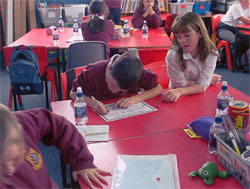|
Piagetian Cognitive Conflict Peer Learning
 Piaget’s theories of collaborative learning stem from the theories of equilibration. In this learning model there has to be reconciliation between prior and newly experienced beliefs. The new belief needs to be close enough to the existing belief that the learner can relate it to previous learning. Peer learning is productive so long as beliefs differ and tasks are structured to draw out the conflict between the existing/new belief (Foot & Howe,1998). This leads to the existing cognitive structure being displaced and a new structure taking its place. The role of peer interaction in this instance would be to instruct, tutor and lead learners towards internal cognitive development. De Lisi and Golbeck (1999) presented a model of how Piagetian principles of peer learning promoted cognitive growth. Cognitive growth was facilitated within the operational cognitive system (i.e. that which controls thinking processes as opposed to the sensory-motor system which controls motor response to stimulus). Hypotheses developed within the operational system are tested with a peer learner. The event may lead to assimilation (the child allowing the event to enter the cognitive structure in order to infer meaning). In turn this leads to accommodation where the cognitive structure is influenced by the event. However, the accommodation does not imply long term change at this point. Retaining the ‘correct’ cognitive structure over time is a more complex process and relies on the child gaining deeper understanding of the new cognitive structure leading to equilibration (successful modification of the cognitive structure). This results in one of three outcomes. Either the new cognitive model does not manifest itself as different from the existing model (the existing model is therefore reinforced). If ‘perturbation’ exists between new and old cognitive structures then the child will go through a process of perturbation-regulation-compensation sequences. This may result in the child rejecting the new model and returning to the old model. However, it may also result in the perturbation impelling change in the child’s cognitive/conceptual systems and the development of a new cognitive structure. This process is summarised in Figure 1. Piaget’s theories of collaborative learning stem from the theories of equilibration. In this learning model there has to be reconciliation between prior and newly experienced beliefs. The new belief needs to be close enough to the existing belief that the learner can relate it to previous learning. Peer learning is productive so long as beliefs differ and tasks are structured to draw out the conflict between the existing/new belief (Foot & Howe,1998). This leads to the existing cognitive structure being displaced and a new structure taking its place. The role of peer interaction in this instance would be to instruct, tutor and lead learners towards internal cognitive development. De Lisi and Golbeck (1999) presented a model of how Piagetian principles of peer learning promoted cognitive growth. Cognitive growth was facilitated within the operational cognitive system (i.e. that which controls thinking processes as opposed to the sensory-motor system which controls motor response to stimulus). Hypotheses developed within the operational system are tested with a peer learner. The event may lead to assimilation (the child allowing the event to enter the cognitive structure in order to infer meaning). In turn this leads to accommodation where the cognitive structure is influenced by the event. However, the accommodation does not imply long term change at this point. Retaining the ‘correct’ cognitive structure over time is a more complex process and relies on the child gaining deeper understanding of the new cognitive structure leading to equilibration (successful modification of the cognitive structure). This results in one of three outcomes. Either the new cognitive model does not manifest itself as different from the existing model (the existing model is therefore reinforced). If ‘perturbation’ exists between new and old cognitive structures then the child will go through a process of perturbation-regulation-compensation sequences. This may result in the child rejecting the new model and returning to the old model. However, it may also result in the perturbation impelling change in the child’s cognitive/conceptual systems and the development of a new cognitive structure. This process is summarised in Figure 1.
Piagetian peer learning techniques have been successfully implemented in schools in literacy, mathematics and science (Webb,1989; Howe, Tolmie, Greer & Mackenzie,1995; Robinson, Schofield & Steers-Wentzell,2005). Central to understanding why Piagetian peer tutoring should result in cognitive restructuring are the ideas of cognitive challenge and post-interactive reflections. Peer tutors offer more possibility of congruence between cognitive structures (therefore more likelihood of understanding the difficulties the learner may experience). This is reported to allow peers to engage in effective dialogue (Allen,1976;Bruner,1985). Therefore, peer learning contexts can provide the right balance between the disequilibrium caused through cognitive challenge and social exchanges between peers, for effective learning to take place (Palinscar,1998).
Video of teacher interacting with children to challenge their previous thinking
|